News reports of devastating flooding following very heavy rains in recent days show how easily lives and memories accumulated over a lifetime can forever change – and quickly – for those who are impacted by floods.
Some homes in areas that were nowhere near a body of water and which had never had any threats from flooding in the past became surprise victims of flooding for the very first time ever. Meanwhile, others have seen their properties flood on multiple occasions. Regardless, the devastation and upheaval left on families has been huge.
Don’t fall victim to 1 in 100 year floods. Typical homeowner policies provide no coverage for loss caused by floods. So it’s important that homeowners consider purchasing special insurance that would provide coverage against flood damage.
Today flood insurance is widely available through the National Flood Insurance Program (NFIP), a partnership between the Federal Emergency Management Agency and the private insurance industry. Residents in communities which participate in the NFIP are eligible to purchase flood insurance; participating communities must adopt certain floodplain management practices in exchange for their residents having access to flood insurance.
Flood coverage can protect both a dwelling and its contents. NFIP policies provide basic coverage up to $250,000 for the building and up to $100,000 for contents. If a home’s value exceeds the amounts available through the federal program, additional excess coverage above the federal limits may be available through a private insurance company.
As with a standard homeowner policy, premiums for flood insurance depend upon several variables, such as the type of occupancy (single family, non-residential, etc.), the amount of coverage provided and the home’s location.
There’s another important consideration associated with flood insurance. Although homeowners can buy flood insurance at any time as long as their house is located within a participating community, there’s a 30 day waiting period before the policy becomes effective. That’s a common provision with all companies so individuals cannot wait until the high water level is 10 feet from the front door before making the decision to purchase coverage.
Homeowners who are interested in obtaining flood coverage should contact their insurance company as a starting point for buying the coverage. If your current company does not offer flood insurance, you can contact the NFIP Telephone Response Center and obtain names of local agents or companies who do sell the coverage.
Have additional questions about flood insurance or need help in finding companies that will offer the coverage? Give us a call. We’re always here to help.
Image credit: Johndal
Article adapted with permission of Broadridge Forefield Investor Communications

